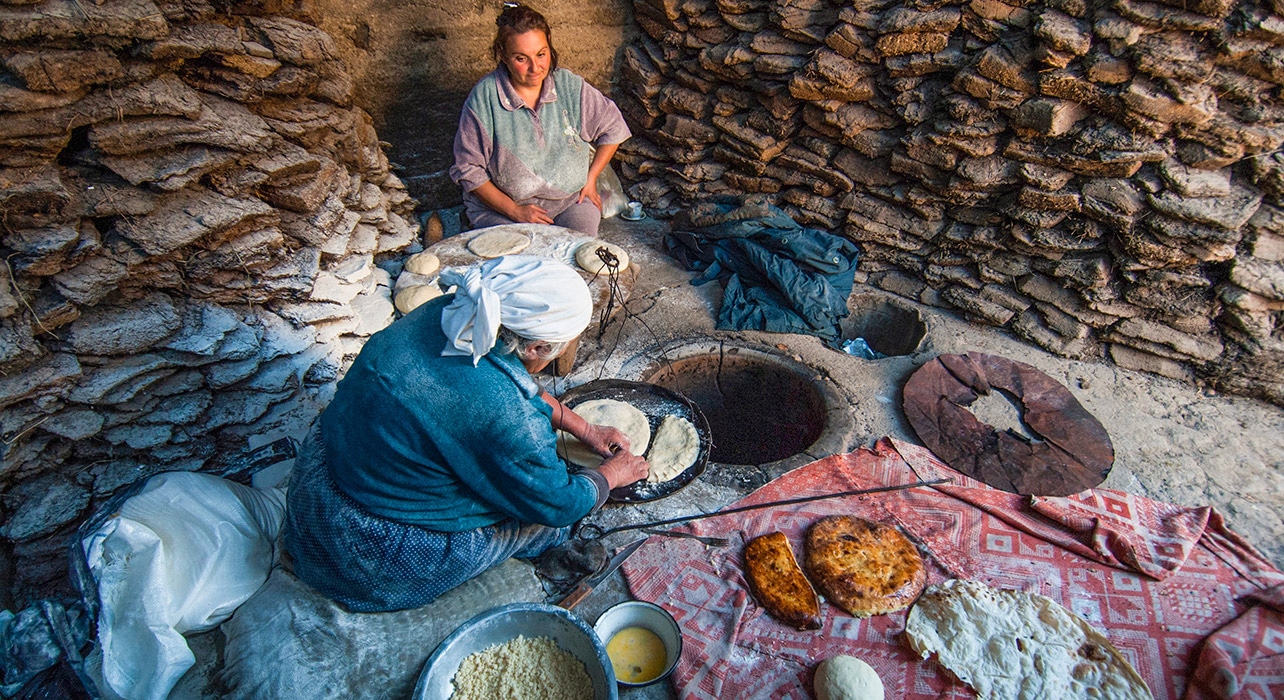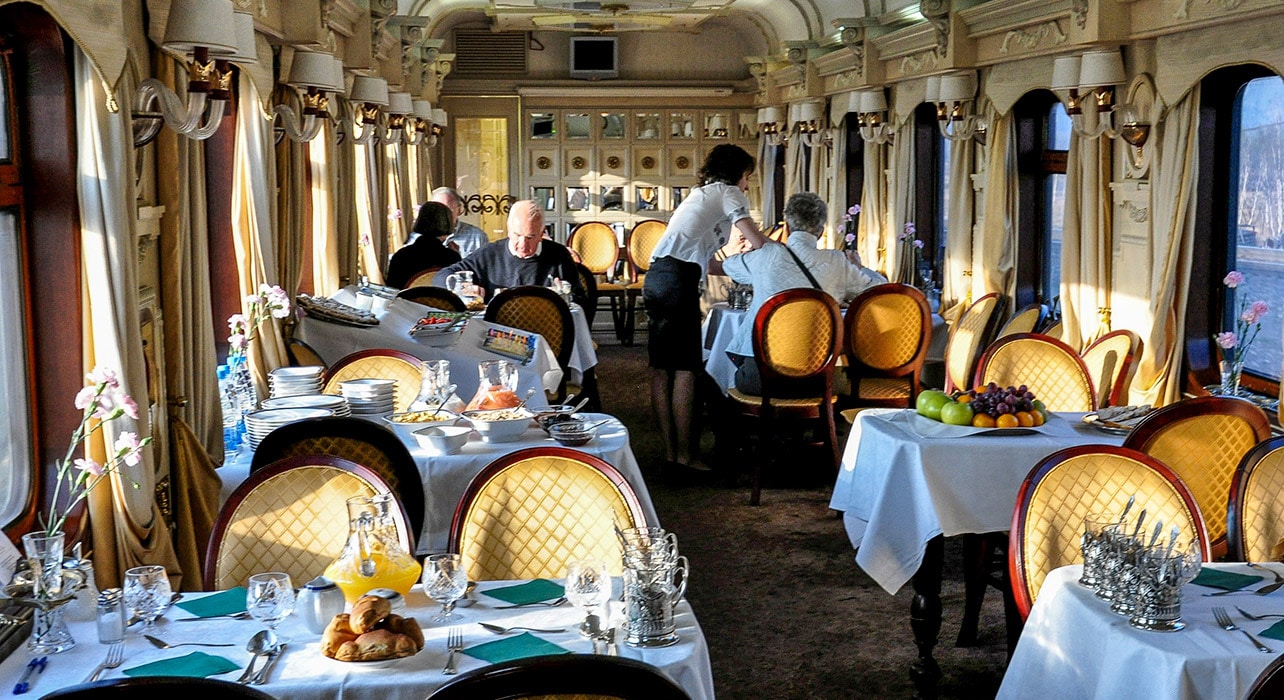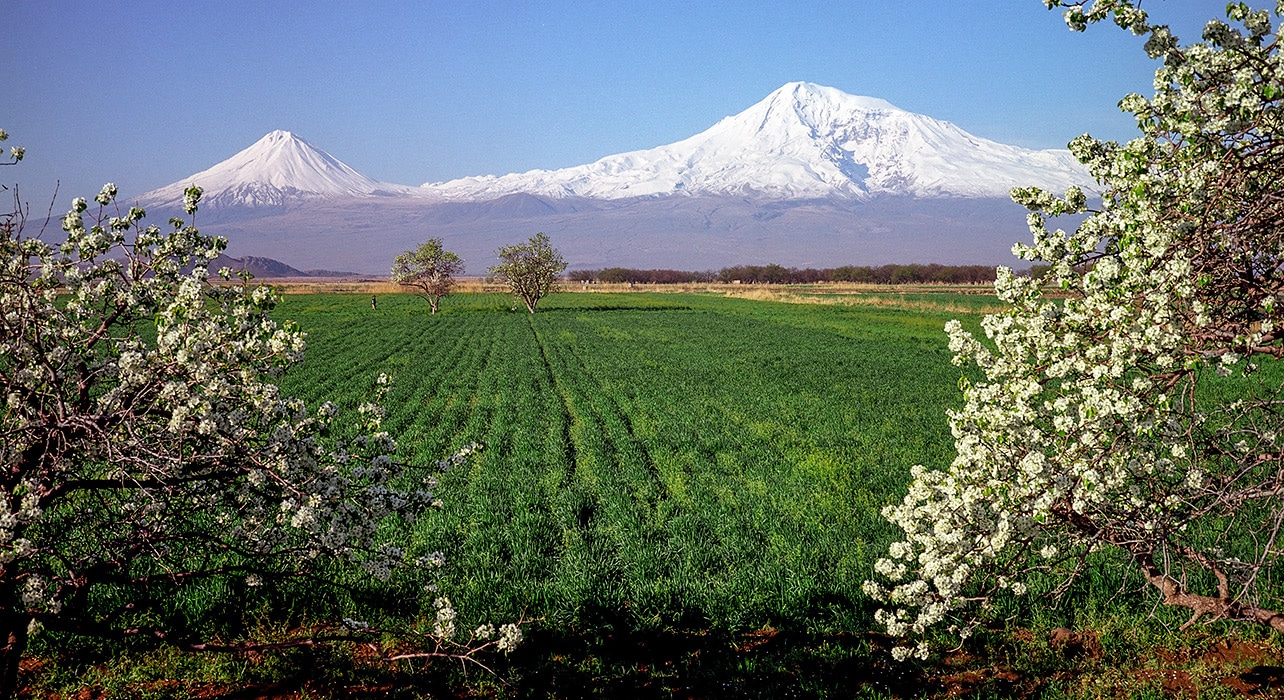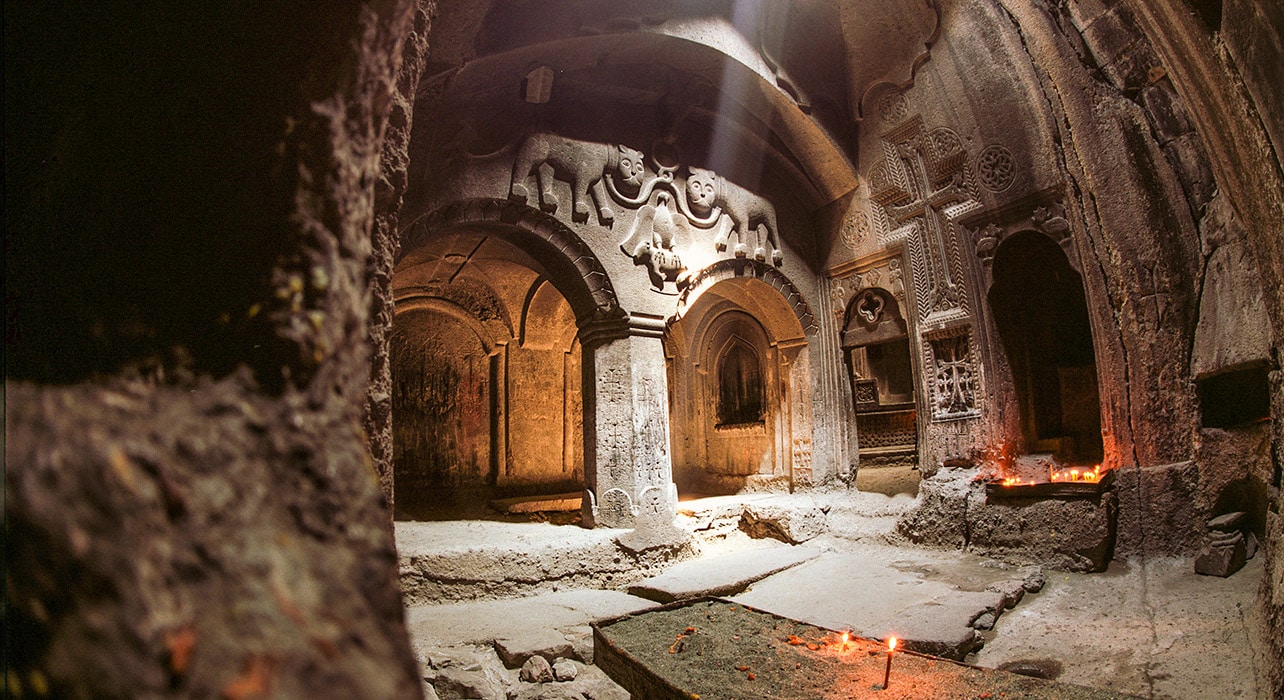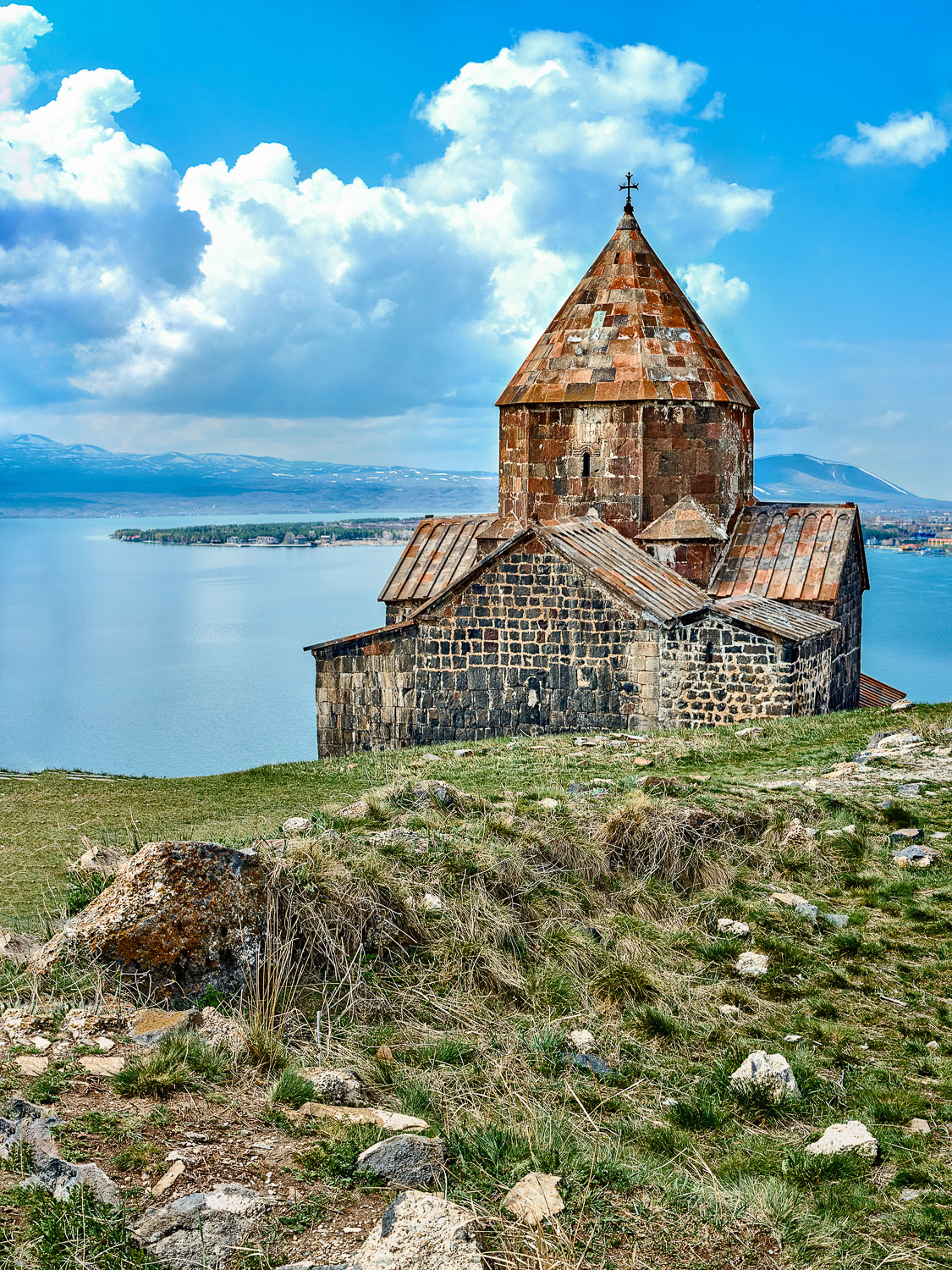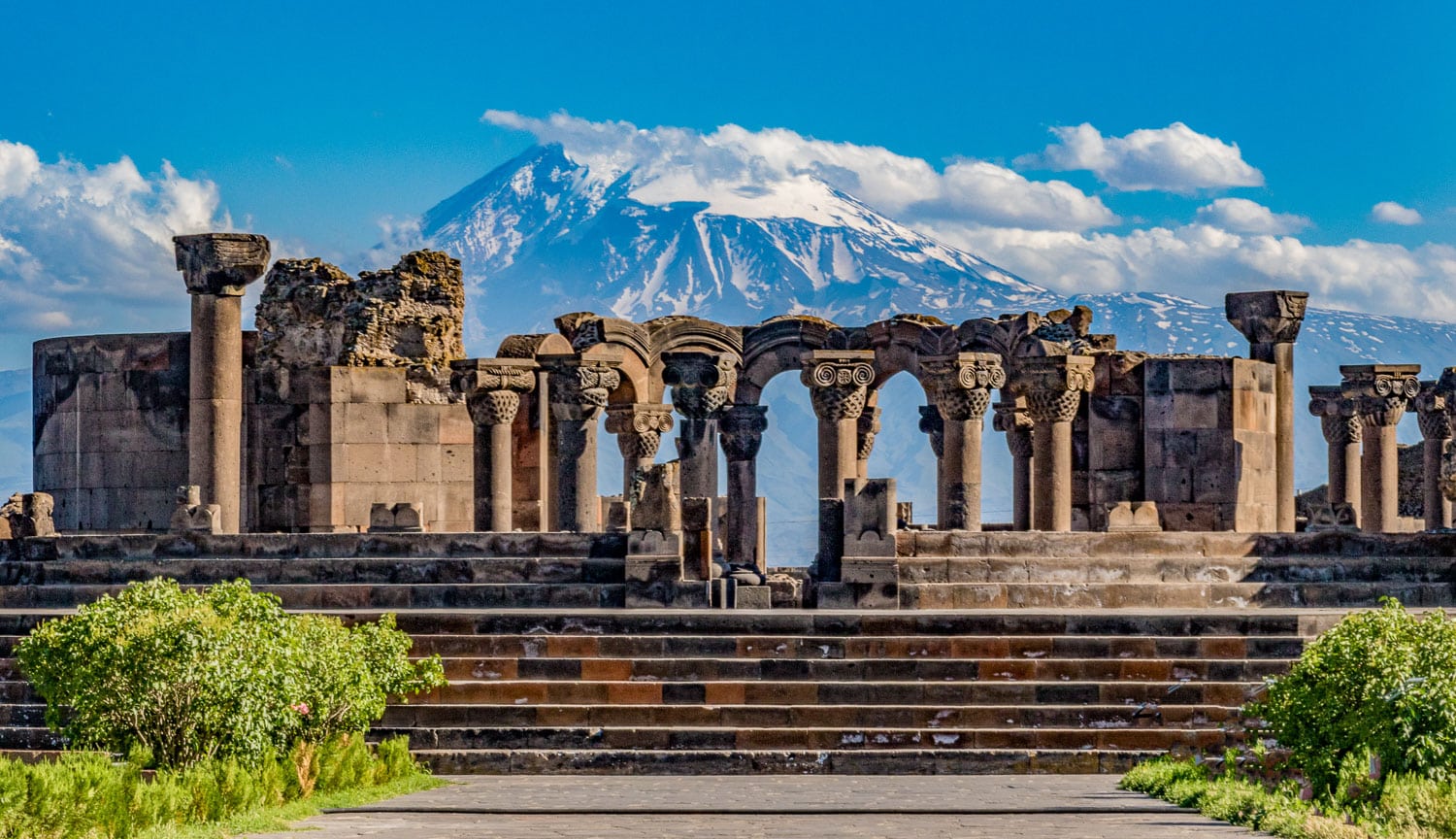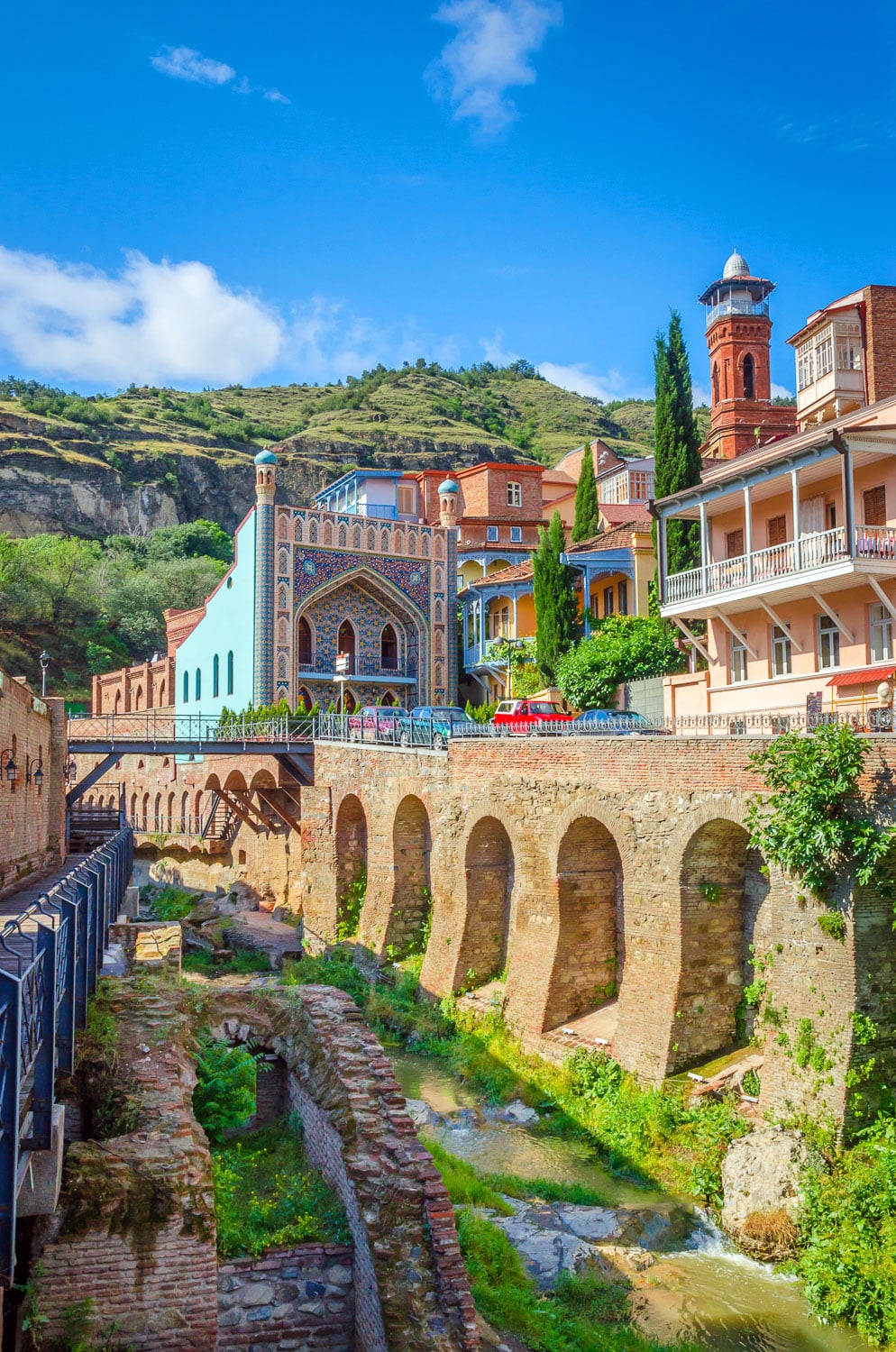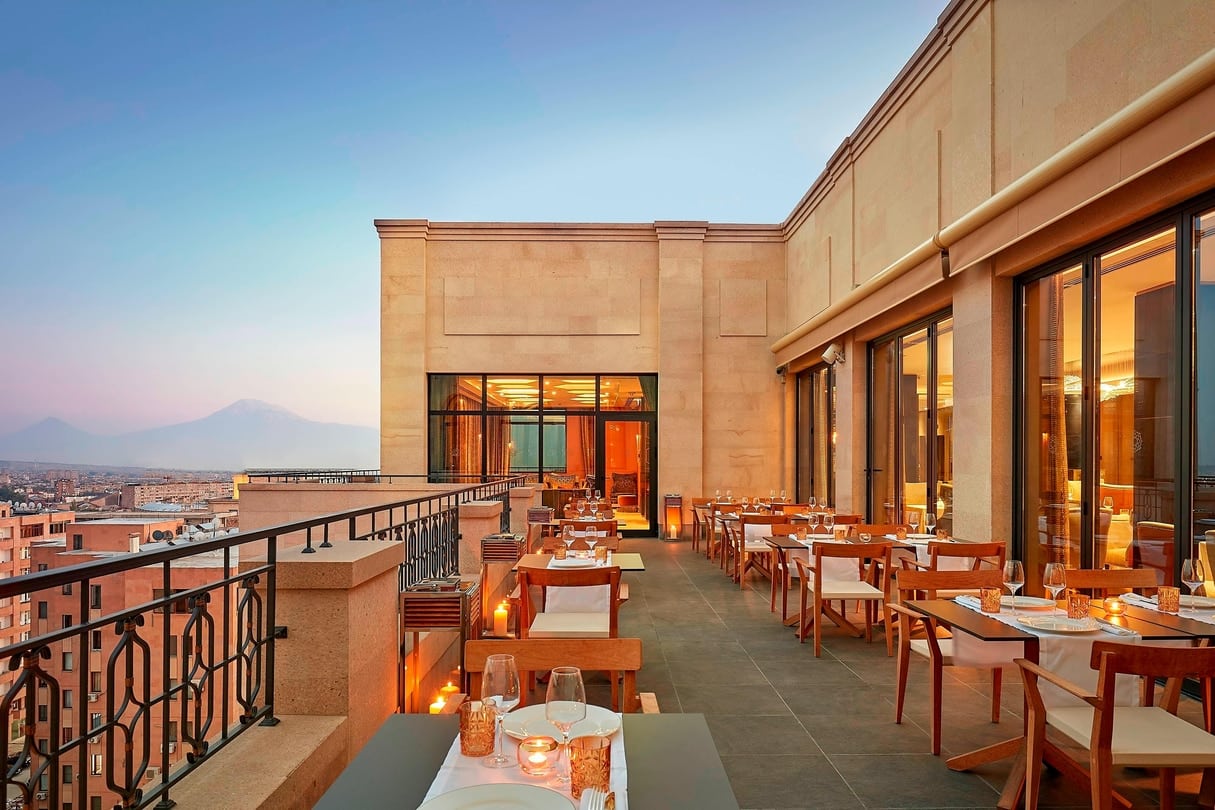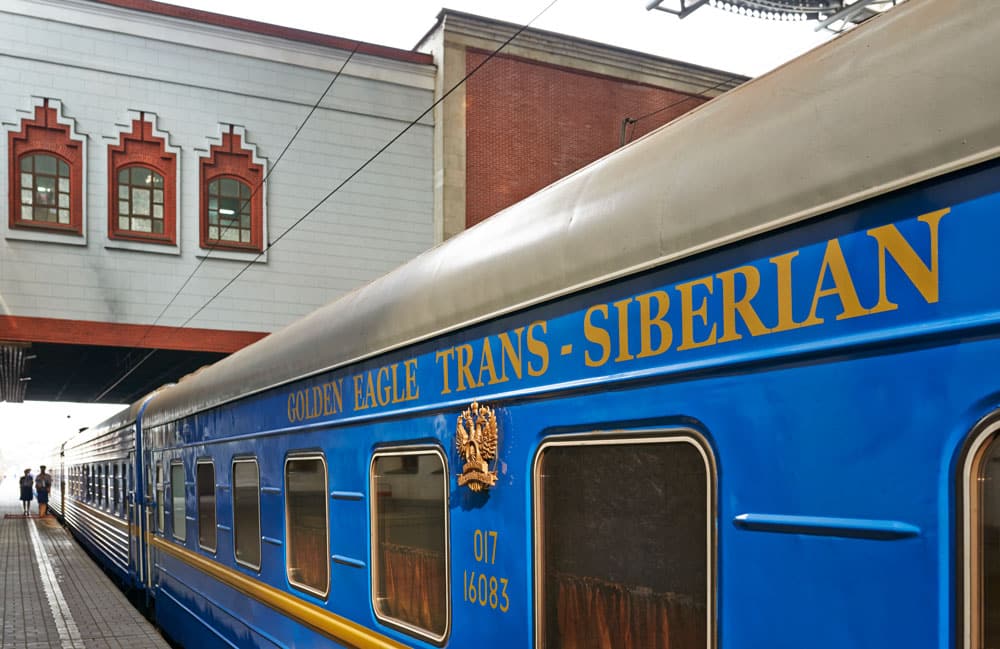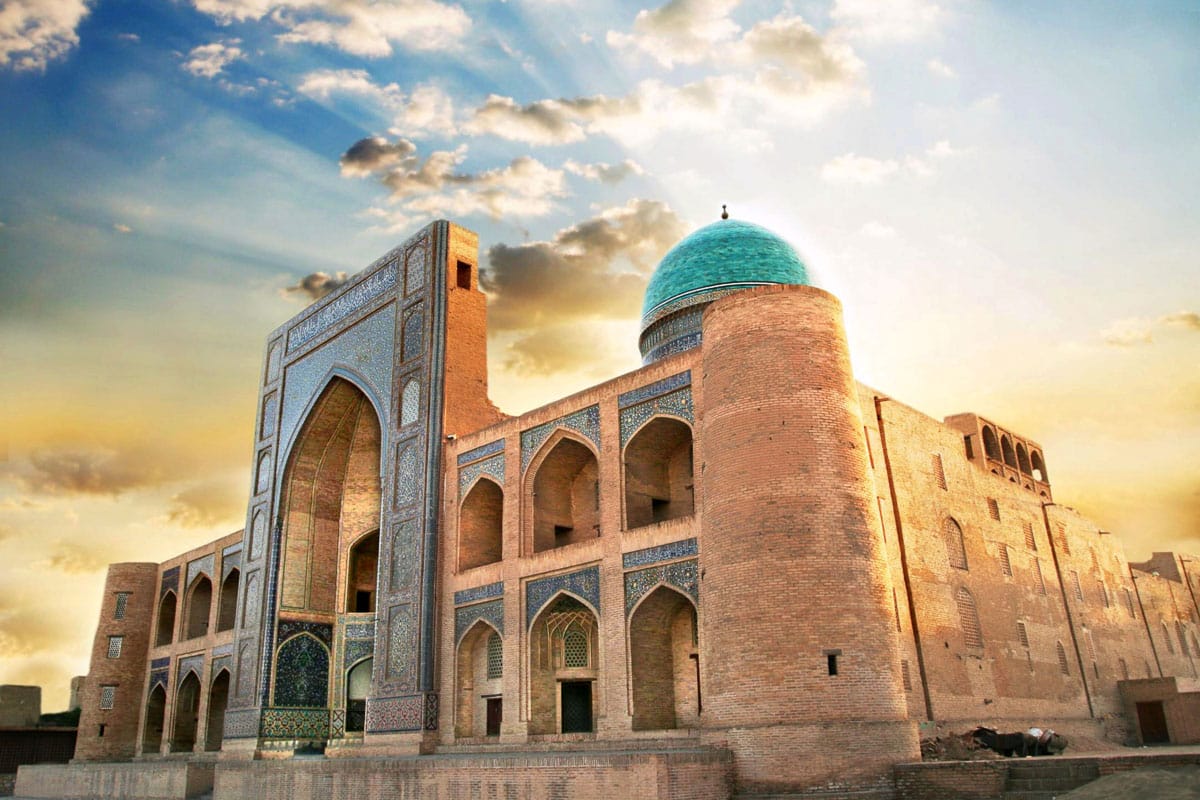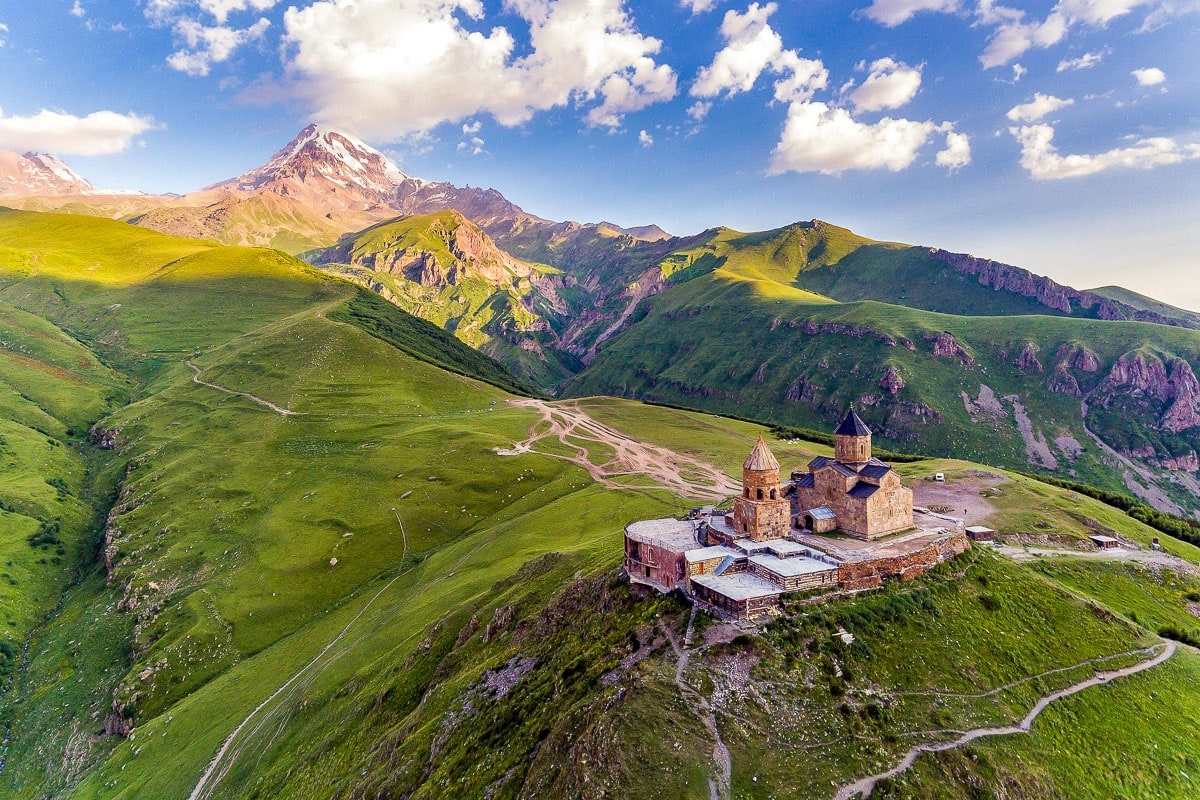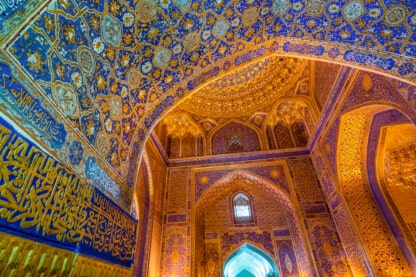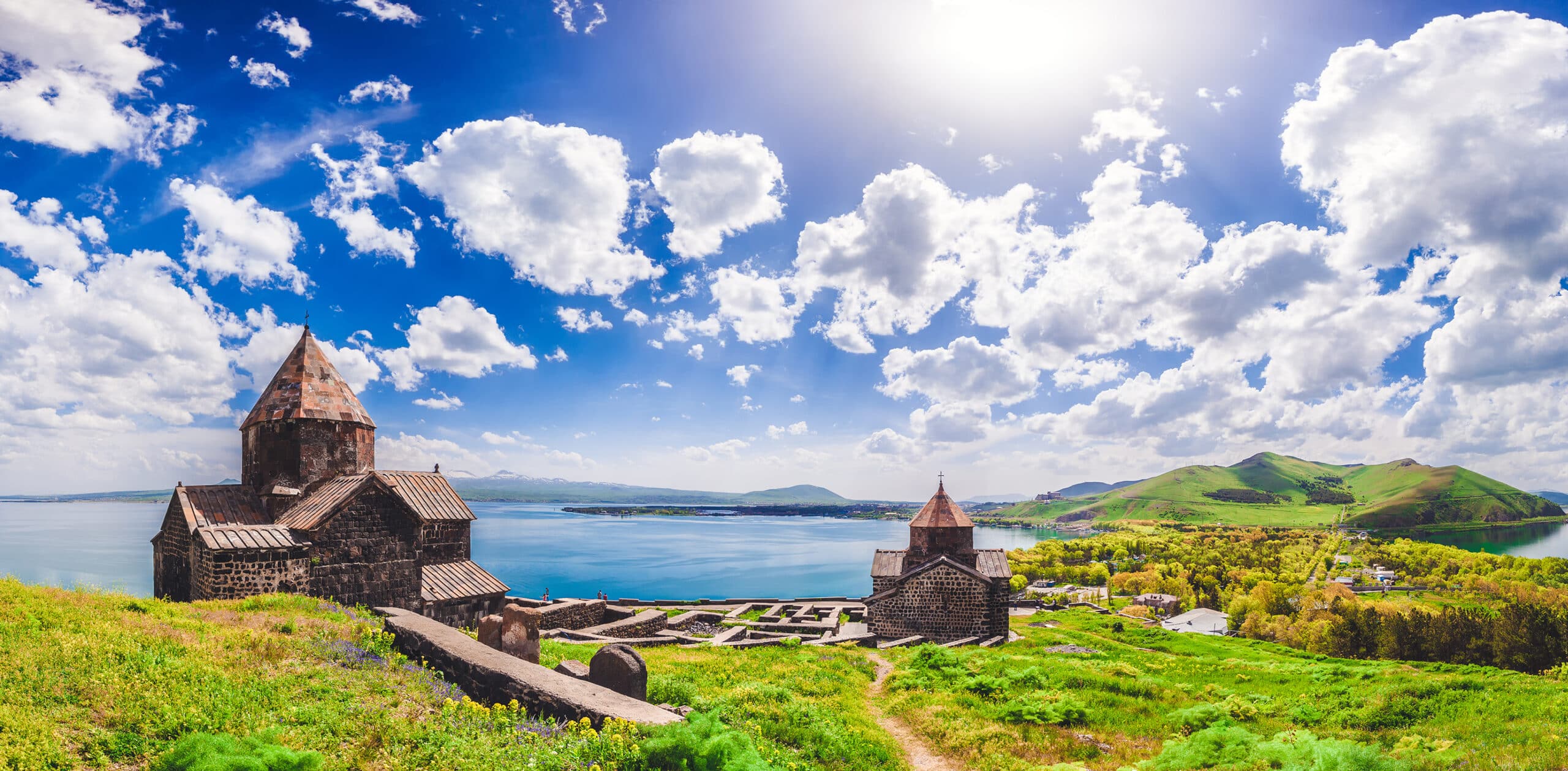
From Yerevan to Almaty by Private Plane and Private Train
Caspian Odyssey
Overview
Seek out the spellbinding magic of the Silk Road on this experiential voyage through the South Caucasus and Central Asia. This extraordinary journey takes in the magnificent countries of Armenia, Georgia, Azerbaijan, Turkmenistan, Uzbekistan, and Kazakhstan—venturing into a part of the world difficult to reach for the ordinary traveler. Situated on a historic crossroads of trade, religion, language, and the arts, this intriguing region is an exquisite melting pot of cultures, cuisines, and communities blending the provincial with the palatial, the ancient with the avant-garde. Meander through the tranquil natural beauty of the South Caucasus region and experience the electrifying buzz of the UNESCO-honored cities of Khiva, Bukhara, and Samarkand over the course of this breathtakingly beautiful 16-day journey.
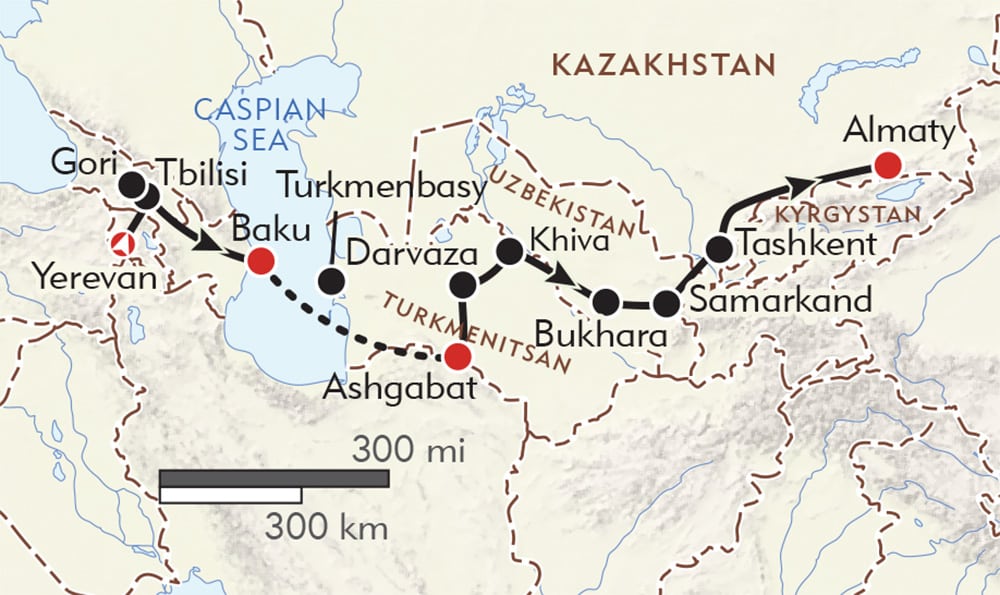

Arrive: Yerevan, Armenia
Depart: Almaty, Kazakhstan
Highlights
- See the prehistoric rock engravings at Gobustan, Azerbaijan
- Discover the old Silk Road outposts of Khiva, Bukhara, and Samarkand
- Explore the cave city of Uplistsikhe, dating from the 6th century
Itinerary
Note: This trip is not exclusive to, nor operated by, Wilderness Travel, who acts solely as an agent in booking your reservation with the operator. Please download the Rate Sheet in the Dates & Pricing section to see the full pricing details and contact our Cruise Collection Specialists to check availability.
For early arrivals to Yerevan, do not miss the opportunity to take advantage this afternoon of a Freedom of Choice option to visit the Mother Cathedral of the Armenian Apostolic Church, often referred to as the Vatican of Armenia. Built in 301 AD, Etchmiadzin is considered the oldest cathedral in the world. During the tour, we will visit the Treasury Museum of Etchmiadzin. The exhibition showcases important Christian relics, such as the pieces of the True Cross, a fragment of Noah's Ark, and the Holy Spear that pierced the body of Christ. After Etchmiadzin we make a brief stop at the UNESCO World Heritage Site of Zvartnots Cathedral. Built in the 7th century, the cathedral features a unique circular shape. From here we make a stop at the Tsitsernakaberd Memorial. This expansive complex, which was completed in 1967, was built to honor the 1.5 million Armenians killed by genocide during the 20th century. Today, the hillside memorial serves as a destination for pilgrims who want to pay homage to the fallen.
Tonight, we will enjoy a Welcome Dinner at an authentic local restaurant—the perfect opportunity to meet meet your fellow travelers and look forward to the journey across six captivating countries of the South Caucasus region and Central Asia.
Our touring will take us 23 miles out of Yerevan to the ancient Geghard Monastery. The beautiful monastery contains a number of churches and tombs, many of them cut into the rock. The complex of medieval architecture is set into a landscape of great natural beauty, surrounded by towering cliffs at the head of the Azat Valley.
We will also visit the 1st century pagan temple of Garni, built to worship the Sun God Mitra. We will have the opportunity to explore the fascinating remains of an ancient fortress, palace, and baths there. Lunch will also be taken at this stunning location.
This evening we head to the Armenia Wine Company, located close to Yerevan. Here we have opportunity to explore the entire process of Armenian wine making technology, walk through the factory cellars, learn about the evolution of Armenian wine making history at the special museum, and try the premium wines followed by authentic and exclusive dinner.
Leaving Yerevan, our journey takes us to Lake Sevan, where we stop for lunch with stunning views. Along with Lake Van and Lake Urmia, Sevan was considered one of the three great lakes of the historical Armenian Kingdom, collectively referred to as the Seas of Armenia; it is the only one within the boundaries of today's Republic of Armenia.
After lunch we continue our way, by coach, to the Armenian-Georgian border in Bagratashen, driving through the spa town of Dilijan, well known for its forest landscapes and medicinal mineral water, before we make a coffee and brandy stop at Avan Dzoraget Hotel, nestled among the forest-covered hills and rocky slopes of the Caucasus Mountains.
This evening we arrive into the Georgian capital of Tbilisi, where we stay for the next three nights at the Marriott Hotel.
Historical sites we visit include the 13th century Metekhi church, a cross cupola church that forms part of the Royal Residential complex, and the 5th century Sioni Cathedral, the main church of Tbilisi. We will also visit the recently built Holy Trinity Cathedral, one of the largest Orthodox churches in the world, and take a walking tour of the old town and Rustaveli Avenue. Here we will see the Great Hall of the Georgian Philharmonia. Built between 1969-71, it has been acknowledged as one of the finest public buildings since the Second World War. Moreover, there will be the chance to see the treasures of the city housed in the Janashia Museum of Georgia.
The famous cave city of Uplistsikhe dates from the 6th century BC and is first mentioned in the chronicles of the 1st century AD. Carved into rocky plateau we find huge echoing halls, meandering corridor-streets, chambers for pagan worship, and even the remains of Georgia's oldest theater complete with auditorium, stage, and orchestra pit. Like the other cave-towns of Georgia, it is rooted in the prehistoric traditions of the peoples of the Near East. On one side the fortress was protected by the Mtkvari and an almost vertical rock face; on the other, by powerful fortifications. Its strategic position on the approaches to Gori and its strong defenses made it possible to control the surrounding terrain. There were numerous attempts to destroy Uplistsikhe. Only in the 13th century, however, did the hordes of Genghis Khan's son Khulagu succeed in doing so, after capturing and destroying many fortresses in Transcaucasia with the help of siege machines. The 5,000 inhabitants of Uplistsikhe perished and life ended forever in the fortress.
In the late afternoon, our explorations will take us to the city of Mtskheta, Georgia's old capital. Due to its historical significance and numerous ancient monuments, Mtskheta became a UNESCO World Heritage Site in 1994. Today we will also enjoy a private performance of traditional Georgian polyphonic singing—this is an immersive experience that offers a truly unique insight into the beautiful local culture and heritage.
Upon arrival we will board the Golden Eagle. Once settled into our cabins, lunch will be served in the Restaurant Cars. This afternoon we have the opportunity to explore Ashgabat; highlights on our panoramic city tour include visits to the National Museum and Wedding Palace.
The Golden Eagle departs Ashgabat at lunch and makes a scheduled stop tonight at Ichoguz. We leave the train and make a short journey to Darvaza's famous burning gas crater, a spectacular sight best seen at night. Located in the middle of the Kara Kum desert where the area is rich in natural gas, the 230-foot-wide crater is known by the locals as the "Door to Hell" and has been burning for over 40 years. It's a unique experience that is not to be missed.
Immerse yourself in the lively pulse of the city as we explore the bustling Trading Domes of Bukhara and gather at Lyabi-Hauz Square, a vibrant social hub cocooned by a pool and embraced by the soothing shade of mulberry trees and local tea rooms.
This evening, weather permitting, we will enjoy a barbecue on the station platform before our train departs—a unique farewell to an incredible city.
Accommodations
Scroll through our signature accommodations for this trip below. Although it is highly unlikely, we may make substitutions when necessary.
What the Trip is Like
The trip is rated Level 1+, Easy, and is appropriate for anyone in good health who is physically active. Light walking and hiking are required to scenic nature areas, local towns, villages, and sites of historical and cultural interest.
A particular charm of the Golden Eagle is the beautifully appointed restaurant cars, a delightful venue in which to enjoy meals skillfully prepared by the Executive Chef and his on-board restaurant team using the very best ingredients locally sourced whenever possible. Depending on the number of guests on board, one or two restaurant cars will be on every departure.
Enjoy the pleasures of an on-train breakfast each morning -- the wonderful aroma of freshly-baked bread permeates the dining car, a wide selection of pastries, cereals, freshly squeezed orange juice and cold plates are available from the buffet. Alternatively, enjoy a cooked breakfast brought to your table by the wait staff, all complemented by hot tea and coffee. If you are in need of a more relaxed start to the day, then opt for a continental breakfast basket with tea or coffee to enjoy at leisure in your cabin.
For lunch and dinner you will be welcomed by the on-board team and enjoy fine food, great wines and attentive service in the welcoming atmosphere of the dining car. The Golden Eagle offers a culinary experience that reflects the essence of the places you visit, as well as highly accomplished international cuisine. Vegetarian and other dietary options are also available.
During your tour, you will be personally invited to a special dining occasion, our celebrated Caviar Dinner, savoring gastronomic specialties including black sturgeon and red pacific salmon caviar.
Meals at lunch and dinner are complemented by an excellent choice of wines from around the world. Meals are a relaxed affair as the restaurant cars can accommodate all our guests in a single sitting. Throughout the journey there is an informal dress code, and with the open-seating policy you can dine wherever, and with whomever, you please.
Please note that no alcoholic drinks will be served on or off the train if travelling through Iran.
On a typical day, the Golden Eagle will travel through the night, as you sleep in your private cabin. Disembarking after breakfast the following morning, you will set out by coach or minibus to explore, for example, the sights and sounds of Samarkand, Mashhad, Persepolis and Tashkent, and at the end of the day return to the sanctuary of your hotel-on-wheels, greeted by your cabin attendants with complimentary refreshments.
Some days will be spent partly or entirely on board the train providing an opportunity for guests to watch the landscape unfold. The Golden Eagle offers different on-board activities and facilities so you might spend the time attending talks on the local history and culture, trying your hand at bridge, improving your photographic skills, or simply soaking up the atmosphere and enjoying afternoon tea in the Bar Lounge Car. Perhaps read a novel from the library, challenge your friends to a game of bridge or backgammon, or attend an engaging talk given by on-board lecturers on local history and culture.
During morning or afternoon tea in the Bar Lounge Car with delicious, freshly baked pastries, your Tour Manager will organize a program of activities. Passengers will receive printed daily itineraries throughout the tour detailing train arrival and departure timings, latest weather forecasts for the next destination, and information on the following day's excursions and activities. In the evening, enjoy the sounds of the resident pianist playing on the baby grand piano in the Bar Lounge Car. From time to time, there are special concerts. Every night the bar stays open until the last person leaves.
Client Testimonials
"Very interesting trip in all aspects."
Beri B.
Los Alamitos, CA
Other Trips You Might Like
Browse All TripsBook your trip today
Our Area Specialists know every detail about our tours. They will be happy to answer any questions and help you choose the journey that’s right for you. Contact us to learn more or book your trip today!
Itinerary
Submit the form below to download itinerary
Trip Levels
With more than 200 different adventures to choose from, we want to help you find the trip that’s right for you. Our Trip Level system ranks each trip in two ways: a number rating from 1 to 6 according to the activity, and general travel rigors. 1 is the easiest and 6+ the most difficult—see descriptions below for explanations of each number. A plus (+) sign means the trip is a bit more strenuous than other trips of that level. The detailed explanation of each trip—below the bar with the number rating—is perhaps more important, specifying activities, altitudes, hiking, and travel conditions. The Detailed Itinerary, available by download or mail, gives further information. Our Area Managers can also answer questions and guide you to the trip that best suits your interests.
Level 1 – Easiest
Non-camping journeys, optional walks, little elevation gain or loss.
Level 2 – Easy to Moderate
Hotel nights and/or safari-style camping, hikes of two to four hours on some days. Other physical activities are sometimes included, such as optional sea kayaking.
Level 3 – Moderate
Half- to full-day hikes (3-6 hours) over rolling countryside on most days, occasional steep trails. Many of our hotel-based walking tours are in this category, as are our snorkeling adventures.
- Tuscany & the Cinque Terre
- Argentina: Hikes and Estancias of Patagonia
- Palau Snorkeling & Sea Kayaking
- Some trips with minimal hiking but rugged travel conditions or long drives, such as Tribal Ghana, Togo & Benin, are Trip Level 3.
Level 4 – Moderate to Strenuous
Full-day hikes (4-6 hours), mountainous terrain, significant elevation gains and losses (hiking up or down as much as 3,000 feet) on many days. Altitudes no greater than about 10,000 feet.
Level 5 – Strenuous
Full-day hikes (4-8 hours), mountainous, steep terrain (hiking up or down as much as 3,500 feet) on many days. Trips with hiking at average altitudes of 10,000 to 12,000 feet are in this category.
Level 6 – Very Strenuous
Full-day hikes (5-8 hours), mountainous, steep terrain (hiking up or down as much as 3,500 feet) on many days. Most hikes take place at altitudes above 10,000 feet, with some days ascending as high as 18,000 feet.


